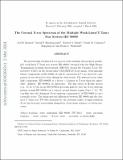| dc.contributor.author | Kastner, Joel H. | |
| dc.contributor.author | Huenemoerder, David P. | |
| dc.contributor.author | Schulz, Norbert S. | |
| dc.contributor.author | Canizares, Claude R. | |
| dc.contributor.author | Li, Jingqiang | |
| dc.contributor.author | Weintraub, David A. | |
| dc.date.accessioned | 2012-07-31T18:11:54Z | |
| dc.date.available | 2012-07-31T18:11:54Z | |
| dc.date.issued | 2004-03 | |
| dc.date.submitted | 2004-02 | |
| dc.identifier.issn | 0004-637X | |
| dc.identifier.issn | 1538-4357 | |
| dc.identifier.uri | http://hdl.handle.net/1721.1/71920 | |
| dc.description.abstract | We present high-resolution X-ray spectra of the multiple (hierarchical quadruple) weak-lined T Tauri star system HD 98800, obtained with the High Energy Transmission Grating Spectrograph (HETGS) on board the Chandra X-Ray Observatory. In the zeroth-order Chandra/HETGS X-ray image, both principle binary components of HD 98800 (A and B, separation 0.["]8) are detected; component A was observed to flare during the observation. The infrared excess (dust disk) component, HD 98800B, is a factor of ~4 fainter in X-rays than the apparently "diskless" HD 98800A in quiescence. The line ratios of He-like species (e.g., Ne IX and O VII) in the HD 98800A spectrum indicate that the X-ray-emitting plasma around HD 98800 is in a typical coronal density regime (log n [less than or equal to] 11). We conclude that the dominant X-ray-emitting component(s) of HD 98800 is (are) coronally active. The sharp spectral differences between HD 98800 and the classical T Tauri star TW Hya demonstrate the potential utility of high-resolution X-ray spectroscopy in providing diagnostics of pre-main-sequence accretion processes. | en_US |
| dc.description.sponsorship | Chandra X-ray Observatory (U.S.) (Contract SV3- 73016) | en_US |
| dc.description.sponsorship | Chandra X-ray Observatory (U.S.) (HETG) (Contract NAS8-01129) | en_US |
| dc.language.iso | en_US | |
| dc.publisher | IOP Publishing | en_US |
| dc.relation.isversionof | http://dx.doi.org/10.1086/420769 | en_US |
| dc.rights | Article is made available in accordance with the publisher's policy and may be subject to US copyright law. Please refer to the publisher's site for terms of use. | en_US |
| dc.source | arVix | en_US |
| dc.title | The Coronal X-ray Spectrum of the Multiple Weak-Lined T Tauri Star System HD 98800 | en_US |
| dc.type | Article | en_US |
| dc.identifier.citation | Kastner, Joel H. et al. “The Coronal X-Ray Spectrum of the Multiple Weak-lined T Tauri Star System HD 98800.” The Astrophysical Journal 605.1 (2004): L49–L52. | en_US |
| dc.contributor.department | MIT Kavli Institute for Astrophysics and Space Research | en_US |
| dc.contributor.approver | Canizares, Claude R. | |
| dc.contributor.mitauthor | Huenemoerder, David P. | |
| dc.contributor.mitauthor | Schulz, Norbert S. | |
| dc.contributor.mitauthor | Canizares, Claude R. | |
| dc.relation.journal | Astrophysical Journal | en_US |
| dc.eprint.version | Author's final manuscript | en_US |
| dc.type.uri | http://purl.org/eprint/type/JournalArticle | en_US |
| eprint.status | http://purl.org/eprint/status/PeerReviewed | en_US |
| dspace.orderedauthors | Kastner, Joel H.; Huenemoerder, David P.; Schulz, Norbert S.; Canizares, Claude R.; Li, Jingqiang; Weintraub, David A. | en |
| dc.identifier.orcid | https://orcid.org/0000-0002-5769-8441 | |
| mit.license | PUBLISHER_POLICY | en_US |
| mit.metadata.status | Complete | |
